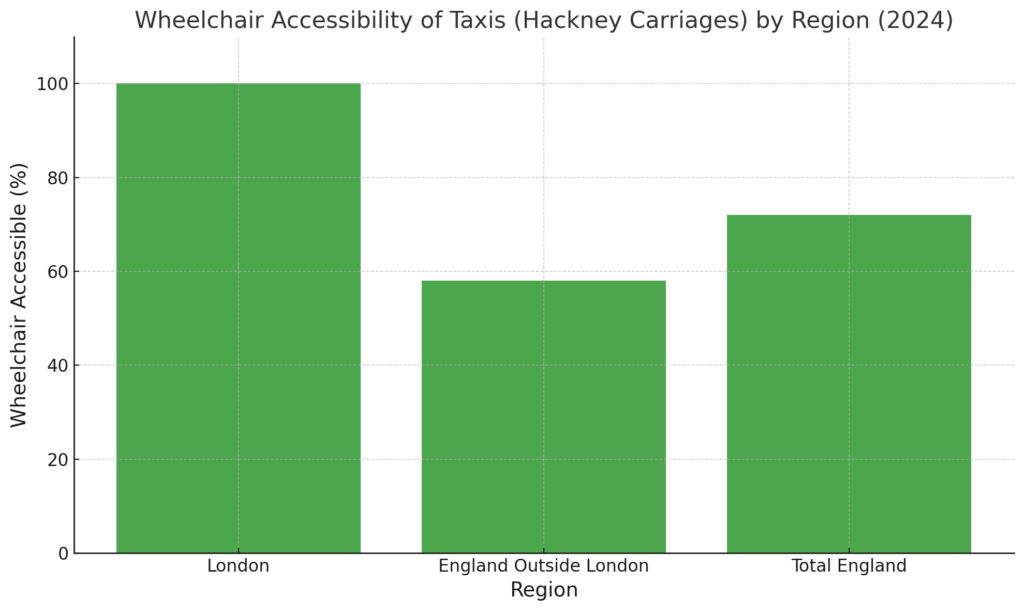Taxis (Hackney Carriages) in the UK: 2024 Statistics and Trends
Introduction
Taxis, commonly known as Hackney Carriages, have been a staple of UK transportation for centuries. From the iconic London black cabs to regional taxis in cities like Manchester and Birmingham, Hackney Carriages provide reliable, metered transport. In 2024, taxis (Hackney Carriages) remain a crucial part of the transport system, though they face growing competition from private hire vehicles and ride-hailing apps.
This article presents a detailed analysis of Taxis (Hackney Carriages) statistics, including fleet size, accessibility, and fares across the UK.
Taxis (Hackney Carriages) Statistics in the UK (2024)
The number of licensed Hackney Carriages in England stands at 34,000, with a large proportion operating in London.
Key Insights
✅ London has 14,800 Hackney Carriages, with all being 100% wheelchair accessible.
✅ Outside London, there are 19,200 taxis, with 58% offering wheelchair accessibility.
✅ The average fare per mile is £3.00 nationwide, but it is higher in London (£3.20).
Regional Breakdown of Taxis (Hackney Carriages)
London: The Heart of Hackney Carriages
- 14,800 taxis operate across the capital, maintaining their status as the most recognizable taxis in the UK.
- 100% wheelchair accessibility, making them essential for disabled passengers.
- Strict licensing regulations, including mandatory knowledge tests (“The Knowledge”) for taxi drivers.
📈 Trend: Despite competition from ride-hailing services, London black cabs remain popular due to their reliability and high accessibility standards.
England Outside London: Decline in Hackney Carriages
- 19,200 taxis operate outside London, spread across major cities.
- Lower wheelchair accessibility (58%), highlighting a gap in disabled-friendly transport options.
- Lower fares (£2.80 per mile on average) compared to London.
📉 Trend: Many taxi drivers outside London are shifting to private hire services or ride-hailing apps due to increased competition.
Key Trends Affecting Taxis (Hackney Carriages)
🚖 Declining Taxi Numbers in Some Regions
- The number of Hackney Carriages has declined in many cities due to competition from Uber, Bolt, and private hire vehicles.
- Some local councils have reported a drop in taxi license renewals, as drivers shift to more flexible private hire roles.
♿ Wheelchair Accessibility Challenges
- London taxis remain 100% accessible, but many cities outside London lack fully accessible Hackney Carriages.
- Local councils are increasing incentives for taxi operators to upgrade fleets to meet accessibility standards.
💷 Fare Increases & Cost of Living Pressures
- The average fare per mile (£3.00) has risen due to higher fuel prices and inflation.
- Cities like London charge higher fares (£3.20 per mile) due to higher operating costs (ULEZ charges, congestion fees).
⚡ Shift to Electric Hackney Carriages
- With London’s Ultra Low Emission Zone (ULEZ) regulations, more taxis are switching to electric or hybrid models.
- Over 5,000 electric black cabs are now in operation in London.
Visualising the Data
Wheelchair Accessibility of Taxis (Hackney Carriages)
The graph below shows the proportion of wheelchair-accessible taxis in different regions.

Number of Taxis (Hackney Carriages) by Region
This bar chart highlights the total number of licensed taxis in different regions.

Average Fare per Mile for Hackney Carriages
This chart compares the cost per mile for taxis in London and other areas.

Future Outlook for Taxis (Hackney Carriages)
📌 Technology Integration
- Many Hackney Carriages are now integrating app-based booking systems to compete with private hire services.
- New taxi apps (like Gett and FreeNow) are helping traditional taxis remain competitive against Uber and Bolt.
⚡ Sustainability & Low-Emission Taxis
- The push for zero-emission vehicles is accelerating fleet transitions to electric black cabs.
- More cities are introducing green incentives to encourage taxi operators to adopt EV taxis.
📈 Projected Growth in Niche Markets
- Hackney Carriages are increasingly focusing on airport transfers, corporate clients, and regulated transport services to remain profitable.
- Some local councils are capping new taxi licenses, ensuring controlled growth in the sector.
Conclusion
The Hackney Carriage industry remains a vital part of the UK transport sector, with 34,000 taxis in operation nationwide. Despite increased competition from private hire services, London’s black cabs continue to thrive, especially with their 100% wheelchair accessibility and iconic status.
The future of taxis (Hackney Carriages) depends on technology adoption, fleet electrification, and accessibility improvements. Operators who embrace sustainability and modern booking platforms will stay competitive in the evolving transport landscape.
